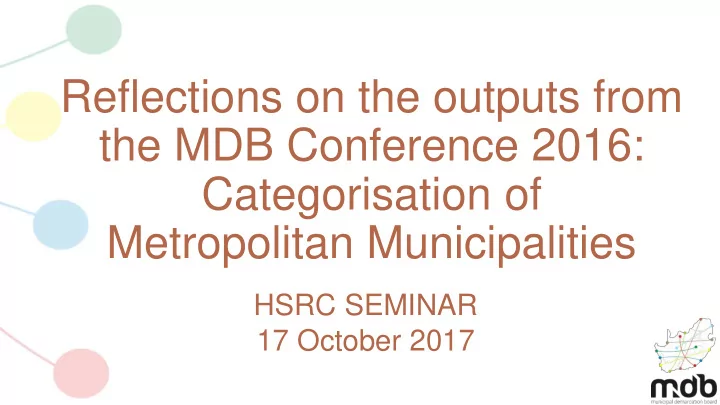

Reflections on the outputs from the MDB Conference 2016: Categorisation of Metropolitan Municipalities HSRC SEMINAR 17 October 2017
Presentation outline 1. Introduction 2. MDB 2016 Conference: Theme 5 3. Inclusive City Growth 4. Role of Metros in national economy 5. Lessons learned 6. Criteria for categorisation 7. Conclusions
MDB 2016 Conference 1. The MDB hosted a Conference on Demarcation and Spatial Transformation in June 2016 2. Theme 5 of the conference dealt with the Metropolitan system of governance and the issues and challenges around that system 3. Two presentations were made under this theme: a. Inclusive city growth: Why governance and collaborative leadership matter by Andrew Boraine, CEO, Western Cape Economic Development b. Getting Cities to Work in SA by Prof Ivan Turok, Human Sciences Research Council 65
MDB 2016 Conference A panellist discussion on the theme centred around the following: 1. Getting cities to work in South Africa 2. Inclusive growth – why governance and collaborative leadership matter 3. The role metros play in the national economy (metros as engines for economic growth) 4. Case study (Tshwane/Metsweding) – what could have been done differently? 5. Criteria for categorisation of metros and their application and the establishment of future metros
Criteria for Categorisation In terms of the MSA, a metro (category A municipality) must be: 1. A conurbation featuring: a. Areas of high population density b. An intense movement of people, goods and services c. Extensive development d. Multiple business districts and industrial areas e. A centre of economic activity with a complex and diverse economy f. A single area for which integrated development planning is desirable g. Strong interdependent social and economic linkages between its constituent units. 2. The application of the above criteria may have been applied too broadly and caused the agglomeration of externalities to become diluted…
Getting Cities to Work in SA Prof Ivan Turok presented that big cities are special but there is an urban premium: 1. Generate disproportionate benefits 2. Productivity, Innovation, Growth 3. Strategic economic assets are viable 4. Airports, seaports, universities, professional and business services, logistics etc 5. But also higher costs 6. Land and property prices 7. Alleviating congestion & pollution 8. Public transport systems
Getting Cities to Work in SA SA cities are held back by : a. Low density sprawl and fragmentation b. Deep social divisions inhibit interaction Public – private mistrust c. d. Split functional responsibilities: • Transport, housing, spatial planning, public land ownership, strategic assets e. Administrative silos reflecting immaturity So: a. Different treatment by government is vital b. Limit the number of metros Don’t dilute the focus with wide boundaries c.
Role of Metros in National Economy 1. Agglomeration of externalities - benefits that organisations or companies obtain by locating near each other 2. Increased economies of scale and networking effects, resulting in: a. Productivity b. Learning c. Innovation d. Growth in jobs and incomes 3. Cities need to be supported by: a. Building relationships and cross-boundary collaboration (soft power) b. Not by redrawing boundaries c. Nor by institutional restructuring
Inclusive Growth Mr Andrew Boraine presented that: a. Effective metropolitan system of governance is an essential ingredient for successful socio-economic development b. Metropolitan growth and inclusion agendas are not mutually exclusive c. Partnering and collaborative leadership is require forsuccessful implementation d. Cities and metropolitan areas are engines of national growth and competitiveness e. Cities are hubs for innovation, commerce, culture, science, productivity, social development and much more
Inclusive Growth 1. To grow, SA must put cities at the heart of the economy 2. By concentrating economic activity, cultural diversity, learning, innovation and creativity, cities can enable the country to establish a competitive advantage and allow its people to advance socially and economically 3. Partnering is important due to declining public sector revenues, where government has to deliver more (to more) with less 4. Successful economic development is enabled through: a. ‘whole of society’ approach b. building a capable state c. efficient markets and d. a mobilised and involved civil society, not one or the other
Key Emerging Issue 1. The role metros (cities) play in the national economy needs to be recognised and supported 2. Development frameworks and budgets need to be responsive to the impact of urbanisation 3. Funding model of government for cities needs review to find better ways of supporting cities 4. Urban sprawl diminishes the efficiencies of cities and demarcation should not encourage this 5. Demarcation (outer boundaries) less of a pressing issue in cities and metro status should not be seen as a solution to local government challenges
Key Emerging Issue 6. Coalitions and partnerships between and among government, private sector and civil society across boundaries and functional divisions is required for cities to be successful 7. Powers and functions with respect to capable metros needs review (for example housing, transport, etc.) – this could release funds and capacity for areas where it is needed 8. The metropolitan system of governance vis-à-vis primary cities requires re-thinking: • Avoid a “one -size-fits- all” approach • Primary, secondary and intermediate cities
Key Emerging Issue 9. Softer issues should receive more prominence when considering metros, such as: a. Partnerships and collaborative programmes b. Co-operative governance c. Social cohesion d. Job creation and improvement of urban conditions 10.Metro categorisation must be supported by rational objectives and not a desire for status or imagined governance autonomy 11.Not all cities have metro potential but local municipalties are not all equal 12.Metros require redefinition in the South African context
Conclusion 1. The application of the above criteria may have been applied too broadly and caused the agglomeration of externalities to become diluted 2. Metros need to be recognised as special and treated as such 3. Role of other primary cities needs to be defined and supported 4. Partnering and co-operative government is essential 5. The MDB is therefore reconsidering the categorisation of metros and conducting research in this regard
Recommend
More recommend